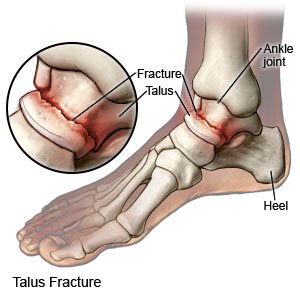Talar Fracture in Adults
Medically reviewed by Drugs.com. Last updated on Apr 6, 2025.
What is a talar fracture?
A talar fracture is a break in the talus bone of your foot. The talus bone is a square, flat bone on top of the calcaneus (heel bone). It connects the heel with the lower leg bones to form the ankle.
 |
What are the signs and symptoms of a talar fracture?
- Pain, tenderness, or swelling
- Bruising or warm skin
- Trouble moving your ankle or foot
- Not being able to put weight on your ankle or foot
- Ankle bones that look out of place
How is a talar fracture diagnosed?
- An x-ray, CT scan, or MRI may be used to check for a fracture or other problem. Contrast liquid may be used to help your ankle show up better in pictures. Tell the healthcare provider if you have ever had an allergic reaction to contrast liquid. Do not enter the MRI room with anything metal. Metal can cause serious injury. Tell the healthcare provider if you have any metal in or on your body.
- A bone scan is a test to look at the bones in your ankle. The bone scan may show a fracture or infection. You will get a radioactive liquid, called a tracer, that collects in your bones. Pictures will then be taken.
- Arthroscopy is used to look inside your ankle to check for signs of fracture or injury. A small incision is made in your ankle and a scope is inserted. A scope is a flexible tube with a light and camera on the end.
How is a talar fracture treated?
- Support devices such as casts and removable boots prevent ankle movement and help your talar fracture heal. A support device may be the only treatment you need. Crutches can help you move around until the bone heals.
- Medicines may be given to prevent or treat pain or a bacterial infection.
- Surgery may be needed for a severe fracture or the bones are broken into many pieces. Wires, pins, or metal plates may be used to hold the pieces together in the correct position.
Call your local emergency number (911 in the US) if:
- You suddenly feel lightheaded and short of breath.
- You have chest pain when you take a deep breath or cough.
- You cough up blood.
When should I seek immediate care?
- You have severe pain.
- Your cast breaks or gets damaged.
- Your toes are numb, swollen, cold, or pale.
- Your leg feels warm, tender, and painful. It may look swollen and red.
When should I call my doctor?
- You have a fever.
- You have new blood stains or a bad smell coming from under your cast.
- You have increased pain or swelling, even after treatment.
- You have questions or concerns about your condition or care.
Care Agreement
You have the right to help plan your care. Learn about your health condition and how it may be treated. Discuss treatment options with your healthcare providers to decide what care you want to receive. You always have the right to refuse treatment. The above information is an educational aid only. It is not intended as medical advice for individual conditions or treatments. Talk to your doctor, nurse or pharmacist before following any medical regimen to see if it is safe and effective for you.© Copyright Merative 2025 Information is for End User's use only and may not be sold, redistributed or otherwise used for commercial purposes.
Further information
Always consult your healthcare provider to ensure the information displayed on this page applies to your personal circumstances.
